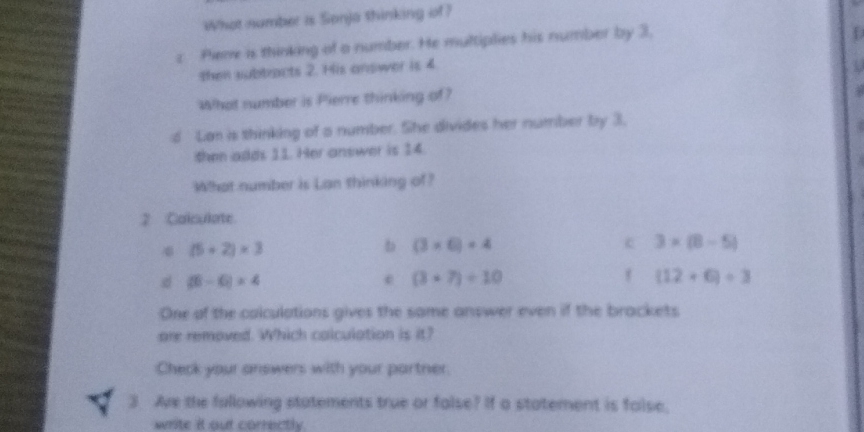What number is Sonja thinking of? Pierre is thinking of a number. He multiplies his number by 3, then subtracts 2. His answer is 4. What number is Pierre thinking of? Lan is thinki... What number is Sonja thinking of? Pierre is thinking of a number. He multiplies his number by 3, then subtracts 2. His answer is 4. What number is Pierre thinking of? Lan is thinking of a number. She divides her number by 3, then adds 11. Her answer is 14. What number is Lan thinking of? Calculate: (5 + 2) × 3, (3 × 4) + 4, (8 - 6) = 4, (3 + 7) = 10, (12 + 6) × 3. One of the calculations gives the same answer even if the brackets are removed. Which calculation is it? Are the following statements true or false? If a statement is false, write it correctly.

Understand the Problem
The question presents several problems involving arithmetic operations and asks to determine specific numbers that Sonja, Pierre, and Lan are thinking of based on given mathematical operations. It also asks to identify which calculation produces the same result even when brackets are not considered. Additionally, there's a request to evaluate statements as true or false.
Answer
- Sonja's number: Unknown, Pierre's number: 2, Lan's number: 9, E: $(3 + 7) = 10$.
Answer for screen readers
- Sonja's number: Unknown
- Pierre's number: 2
- Lan's number: 9
- Calculation that gives the same result without brackets: d: $(3 + 7) = 10$
Steps to Solve
-
Finding Sonja's Number First, we need to determine the number Sonja is thinking of. We don't have specific information about what Sonja does with her number, so we cannot solve this part.
-
Finding Pierre's Number Pierre multiplies his number by 3 and then subtracts 2 to get 4. We can set up the equation: $$ 3x - 2 = 4 $$ where $x$ is the number Pierre is thinking of.
Now solve for $x$: $$ 3x = 4 + 2 $$ $$ 3x = 6 $$ $$ x = \frac{6}{3} = 2 $$
-
Finding Lan's Number Lan divides her number by 3 and then adds 11 to get 14. We set up another equation: $$ \frac{y}{3} + 11 = 14 $$ where $y$ is the number Lan is thinking of.
Now solve for $y$: $$ \frac{y}{3} = 14 - 11 $$ $$ \frac{y}{3} = 3 $$ $$ y = 3 \times 3 = 9 $$
-
Calculating the Expressions Now, let's evaluate the listed calculations:
- a: $(5 + 2) \times 3 = 7 \times 3 = 21$
- b: $(3 \times 4) = 12$
- c: $(3 + 4) = 7$
- d: $(8 - 6) = 2$
- e: $(3 + 7) = 10$
- f: $12 + (4 \times 3) = 12 + 12 = 24$
-
Finding the Matching Calculations Now, we need to check which calculation gives the same result even when brackets are removed:
- For b, without brackets: $3 \times 4 = 12$ also remains the same.
- For e: $(3 + 7 = 10)$ stays the same even without brackets.
-
Final Evaluation We conclude that calculations b: $(3 \times 4) = 12$ and e: $(3 + 7) = 10$ produce the same results when brackets are considered or removed.
- Sonja's number: Unknown
- Pierre's number: 2
- Lan's number: 9
- Calculation that gives the same result without brackets: d: $(3 + 7) = 10$
More Information
This exercise involves algebra and arithmetic operations to determine unknown variables based on given conditions. By manipulating equations, we can find the values that satisfy the equations.
Tips
- Confusing the order of operations when removing or keeping brackets.
- Incorrectly transposing equations, leading to wrong answers.
AI-generated content may contain errors. Please verify critical information